Baduk matches played in Korea are applicable to “Baduk Rules of Korea Baduk Federation” established by Korea Baduk Federation. We introduce simple basic rules divided into 10 categories.
① One Move at a Time : Two players make each one move alternately. In other words, one player may not make two moves or more at once.
② Place for Placement : Place for placing a stone is an empty point where two grid lines intersect. You may not place a stone on a line or space between lines.
③ Freedom of Placement : You may place a stone on any places among the 361 poiints on the board. (※However, points occupied by previous stones or illegal points are exceptions.) It is the point which Baduk is different from chess or Janggi where each piece has a limitation for its moves.
④ No Taking Back : You may not take stones back or move them once they are placed. (※However, wrong placement made by mistake of operating the keyboards or mouse is an exception in an online game.)
⑤ Resignation : Before the end of a game, a player may resign it if the overall position is very bad or there is no chance for winning. It is called defeat by resignation. It is considered as a courtesy in Korean Baduk tradition.
⑥ Removal : In case such as Dia. 4-A, when the four black stones blockades the one white stone’s liberties, black removes the one white stone from the board. Namely, the condition becomes as Dia. 4-B. it is called ‘capturing.’ The captured white stone becomes black’s captive and these stones are used for filling in white’s territories during the counting. (Dia. 4-C is a wrong blockade. If black does not completely blockade the one white stone as this, black is not able to capture the one white stone.)
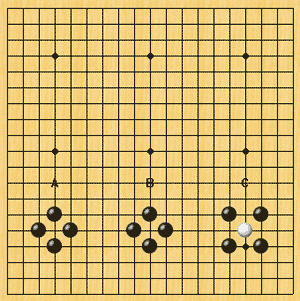 [Dia. 4]
[Dia. 4]⑦ Illegal Points : In Baduk, you can place a stone on any places but exceptionally there are places where you are not allowed to place a stone. In such places as the point ‘a’ in Dia. 5-A which is already blockaded completely by your opponent, you are not allowed to place a stone. (※Exception: In case such as ‘b’ in Dia. 5-B, if it is a place where as soon as you place a stone, you can capture your opponent’s stones, it is not an illegal point for white. Instead, it is an illegal point for black.)
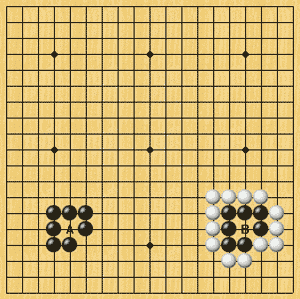 [Dia. 5]
[Dia. 5]⑧ No Repetition : As shown in Dia. 6, this rule is applicable when black and white are in the shape where they are entangled with each other and counter-capture each other. After black captures the one white stone at B1 in Dia. 6-A, if white is allowed to counter-capture B1 at W2, it will be repeated endlessly for black to counter-capture W2 at B3 in Dia. 6-C and for white to counter-capture B3 at W4 in Dia. 6-D. Therefore, this rule is necessary to avoid the repetition. Therefore, right after B1, it is prohibited for white to counter-capture B1 at W2 until white plays elsewhere at least more than once and still has a chance. This is called a ‘Pae’ and the process of negotiating a Pae is called a ‘Pae fight.’
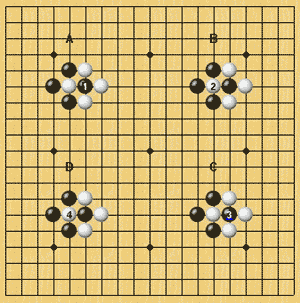 [Dia. 6]
[Dia. 6]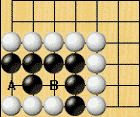 |
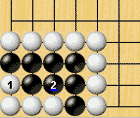 |
| [Dia. 7] | [Dia. 8] |
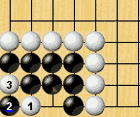 |
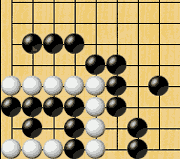 |
| [Dia. 9] | [Dia. 10] |
⑨ Agreement : This rule is a little difficult and the most controversial in Baduk. The most typical case is the shape of bent four in the corner in Dia. 7. The surrounded black stones here are considered to be all dead. Since black cannot play at ‘a’ nor ‘b,’ white’s absolute right to play at ‘a’ at any time on the other hand and make a Pae as shown in Dia. 8 and Dia. 9 is admitted. However, it is only possible until the white stones surrounding the black stones are perfectly alive. In other words, as shown in Dia. 10, the white stones surrounding the black stones are unsettled, the situation changes. In this situation, it goes through the sequence in Dia. 8 and Dia. 9 and the life of both black and white depends on the Pae fight.
⑩ Neutral Space and Reclamation : When filling in neutral points after the closing, black and white must fill in neutral points alternatively. It is to solve the problems of reclamation that might happen when one player fills in for both black and white. However, in a situation where both players agree, either player can fill in neutral points freely.
The basic rules and system of Baduk do not change much in any places of the world. However, since each country has adopted rules partly different from one another without having unified international rules, it sometimes causes some confusion. At present, the most prevailing Baduk rules are the Japanese rules (almost same as Korean rules). The problem is that these rules and the rules used in China and Taiwan are still different. On top of it, ‘Ing rules,’ designed by the late Ing, Chang-ki, the Taiwanese industrialist who have had a great influence on the international Baduk world such as founding the Ing Cup World Baduk Championship, are even different from Chinese rules and Taiwanese rules. Some major differences are briefly shown in comparison with one another as follows.
① Differences of the Units of Territories
What is the most different between Chinese and Taiwanese rules and Korean and Japanese rules is that the units of territories are different. In Korean and Japanese rules, one point is considered as 1 territory whereas one point becomes 1/2 zi (子) in China. In addition, in Taiwan who uses the system of counting points, it is called 1 point.
② Differences of the Ways of Counting Territories
In Korean and Japanese rules, after valid placements with regard to territories are finished (closing the game), both black and white fill in neutral points alternatively that are not related to territories. Korean and Japanese rules adopted the way for each player to count the other player’s territories. At this point, captive stones in each player’s territories and stones that are already captured are used for filling in the other player’s territories.
In Chinese and Taiwanese rules, on the other hand, there are not any concepts particularly related to ‘neutral points.’ Korean and Japanese rules have adopted the subtractive counting way of filling in other players’ territories whereas Chinese and Taiwanese rules adopted the counting way of subtracting captive stones from stones alive on the board.
In Chinese and Taiwanese rules, every point on the board is calculated as a territory. Soon, there will be a chance to explain this in detail.
③ Differences of Illegal Points?
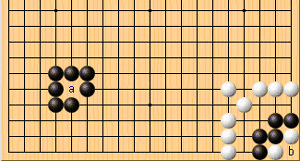 [Dia. 11]
[Dia. 11]
In Korean and Japanese rules, there are definite illegal points as mentioned above. In Dia. 11, both ‘a’ and ‘b’ are illegal points for white. In Chinese and Taiwanese rules on the other hand, white can place a stone on these points. If white place a stone on ‘a,’ the placement is not valid and it becomes black’s turn. In other words, it is as same as white passing its turn (‘pass’).
In case of ‘b,’ it is a little bit more complicated. In Korean and Japanese rules, basically, white is not allowed to place a stone on this point. The surrounded black is completely alive with two eyes.
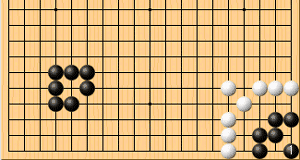 [Dia. 12]
[Dia. 12]
In Chinese and Taiwanese rules, on the other hand, white may place a stone at W1. Then, black has to capture the three white stones at B1 in Dia. 12 to make two eyes. In other words, white may use W1 in Dia. 11 as a powerful Pae threat.
④ Differences of the Compensation and the Time Limit
The compensation currently prevailing in Korea is 6 and half points. In most cases of Japan and China, 5 and half points have been adopted for compensation. Recently in Tianyuan Championship in China, 7 and half points have been adopted for compensation, but it is not any more a still tentative level yet.
On the other hand, In Ing rules, 8 point compensation (7 and half points) and half points have been used since the Ing Cup World Baduk Championship in 1989. On top of it, Ing rules use different systems for the time limit and overtime counting. In general rules, after a player has used a certain limited period of time, the overtime counting is started. In Ing rules, on the other hand, after a player has used the basic time, that player loses 2 points as a penalty. Each player may use each additional time for three times. After each additional time is used, 2 points are lost. (The first player to go over the basic time plus each additional time given for three times will lose on time.)
Besides, there are some other differences related to the bent four as an example between Korean and Japanese rules and Chinese and Taiwanese rules but they are omitted here.




